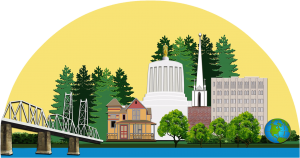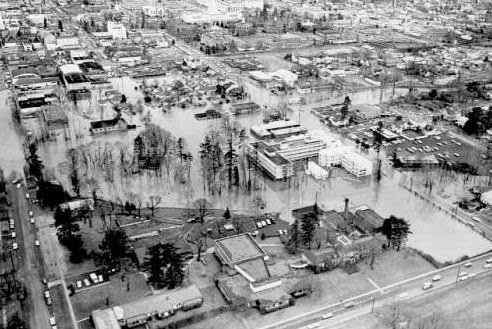World Events
- In his first State of the Union address, Lyndon Johnson announces US will conduct “A War on Poverty.” In November he defeats Conservative Republican Barry Goldwater in presidential election.
- 24th Amendment of the Constitution abolishes poll tax; Civil Rights Act passes in Congress. Martin Luther King, Jr. awarded Nobel Peace Prize for (in part) “having shown us a struggle can be waged without violence”. John Lennon announces Beatles will not play to segregated audience.
- Nelson Mandela given sentence of life imprisonment in South Africa.
- Fifty-four East Germans use tunnel to escape under Berlin wall. Thieves steal the head of Little Mermaid statue in Copenhagen (it is recovered). Italy asks for help to prevent collapse of Pisa’s Leaning Tower.
- Cassius Clay, world boxing champion, changes name to Muhammad Ali. He defeats Sonny Liston in one of the most watched games in the sport.
- U.S. Surgeon General reports smoking may be dangerous to health.
- Alaskan 9.2 earthquake, most powerful ever recorded North America, kills 125 and inflicts massive damage to Anchorage.
- The New York World’s Fair commemorates 300th anniversary of British conquest of Dutch New Amsterdam, renaming it New York. The Verrazano-Narrows bridge across New York Bay opens.
- Academy Awards: “My Fair Lady” (US),”Yesterday, Today and Tomorrow” (Italy). Prize-winning Book: The Centaur, John Updike.
In Salem
Christmas Day brings a flood of the Willamette River and its tributaries within the city when snow and freezing temperatures early in the month gave way to warm temperatures and 4 inches of rain in a 48-hour period. Accumulated snow melted quickly creating a heavy runoff, which by December 22 swelled the Willamette at the rate of three inches per hour at Salem. The next day, the Willamette crested at 37.78 feet. More than 1,000 residents from their Keizer homes and National Guardsmen also helped evacuate 121 patients from Memorial Hospital that suffered from its proximity to Pringle Creek. Salem’s new $3 million sewage treatment plant was disabled by floodwaters, and, although it remained structurally sound, raw sewage began flowing directly into the Willamette River. This happened at other locations along the river as well, creating a major health threat. The State, armed with supplies of typhoid vaccines, braced itself for problems, but fortunately no epidemic resulted.
The flood also hit Boise-Cascade. At the plant on Commercial Street, water filled the basement. 500 employees were put out of work when the plant was knocked out of operation. Some other downtown businesses had as much as 30 inches of water. In the farm areas around the city, agricultural losses were high because the ground had not been able to thaw before the floods hit.
Damages exceeded those of the Columbus Day Storm in 1962. Governor Mark Hatfield declared the entire State an emergency disaster area, and called the flooding, “the worst disaster ever to hit the state.”
(Thanks to Kathleen Clements Carlson and Salemhistory website.)
When you visit
The newspapers of 1964 carried extensive articles and pictures that are still relevant.
The Capital Journal newspaper noted that, without the seven flood control dams on the Willamette River, the River would have crested at 37.5 feet at Salem rather than 30 feet: a height that would rival the 1861 flood that inundated Salem and completely drowned the historic towns of Champoeg and Butteville. In the photographs above, we get an idea of the flooded streets, but even more dramatic is the view of the Union Street Railroad Bridge. Walking across that that pedestrian bridge today, one notices the great distance to the river below. During this flood the waters seem to be just a few feet below the structure.
On December 26, the Oregon Statesman published a four-page pictorial section filled with photographs of the Western Oregon disaster. The front-page title, spread over the page, read, “It Began With Ice… Then Came Snow…Then-Rain…And Then-The Flood…” The final page was titled “Hospital Abandoned” with an aerial picture of the flooded hospital at the Winter and Oak streets intersection and two other photographs of rescued patients. Photographs of the flood waters around the hospital are displayed at the History of Salem Hospital mural in B Building.
Since the majority of downtown Salem and neighborhoods along the river are presently in the “flood plain”, residents need to be aware of emergency services that are available. CERT, (Community Emergency Response Team), sponsored by the Salem Fire Department, is an excellent source of disaster information. Neighborhood volunteer groups are being established. A series of six classes teaches emergency skills that can save lives. Practice exercises are held routinely. The program is managed by Roger Stevenson who can be contacted by telephone at 503 763 3331 or by email at rstevenson@cityofsalem.net. New members are welcome.
Other Events
- This year the City establishes the Salem Human Rights and Relations Commission. This Board aids all, particularly minorities, disabled, and other diverse members of the community, by hearing and resolving discrimination complaints and promoting harmony. Meetings are held the second Tuesday of each month at 6:00 p.m. Special meetings, complaint hearings, and forums may be held as needed. An outstanding 2009 program was a film presentation about past Ku Klux Klan activities in Oregon. It drew a standing-room-only crowd at Loucks Auditorium.
- City Manager Kent Mathewson resigns and Doug Ayers is appointed.
- Mission Mill Museum, Inc. (later Mission Mill Museum Association), is incorporated with the intent of buying the old mill and moving the 1841 Jason Lee House and Methodist Parsonage to the site. David Duniway, Oregon State Archivist 1946-1972, is the first Director of the Association. He also wrote the Salem entry for this year’s edition of the Encyclopedia Britannica.
- Since 1955, Chemeketa Community College classes, operated by Salem Public Schools, had been held at a West Salem elementary school on McNary and 3rd Street. This year it moves to the site of its present site on Lancaster Drive. The campus soon included a one-story brick building, a machine shop, a welding shop, and a number of temporary buildings.
 |
| Water Pumping Station |
- The 1871 water pumping station at Commercial and Trade Streets is razed. In the early years of the city, this station provided power for water distribution from cisterns at various points downtown. The two round buildings were part of the operations between the millrace and Trade Street in the block between Commercial & Liberty streets. The Salem Firehouse #1 is located there now. Construction of the water works was begun in early 1871 and water was being pumped to the homes in Salem by the end of the year. Huge cisterns were located at various points in downtown Salem.
- A former Salem citizen who became President of the United States dies this year. Herbert Hoover, as a ten-year-old orphan, came to Salem in 1885 to live with his uncle and aunt, Henry and Laura Minthorn in their Highland Addition home. Through working with his uncle, president of the Oregon Land Company, he learned many skills that helped him be successful as a member of the “pioneer class” at Stanford University in 1891 and to earn a fortune as a mining engineer. Hoover served as President of the United States from 1929 to 1933. Growing up in Salem, he became acquainted with another orphan, Charles McNary, who also became leading Republican politician of the 1920s and 1930s. In 1947, President Truman brought Hoover back into national service to help make the federal bureaucracy more efficient through the Hoover Commission.


2 Comments